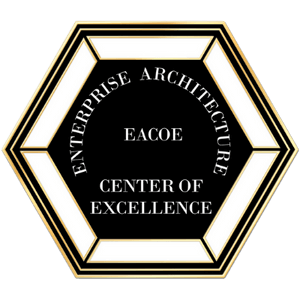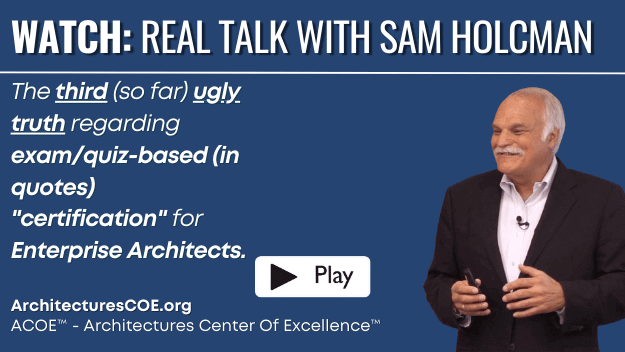
If you are an individual or organization desirous of developing Enterprise Architectures, there are various "self-described" methodologies, frameworks, and certifications. Depending on the complexity and scale of the organizations, people can select from commercial, defense industry, government "frameworks" and "methodologies."
We suggest time will be well spent comparing Enterprise Architecture deliverables, results, frameworks, methodologies, certifications, and more. To assist you with this very important task, we have prepared a guide:
WATCH: The third (so far) ugly truth about exam-based Architect “certifications”
There are primarily two types of organizations that provide Enterprise Architecture frameworks, methodologies, and training;
Franchised-Based Organizations offer Enterprise Architecture Certifications courses and training materials “for lease” and are offered similar to a hamburger-franchise model – the franchised teaching organization pays the course provider a fee, gets the course material, and then has the attendee come back to the franchiser and pays to take a multiple choice exam.
Practitioner-Based Enterprise Architecture Certification from EACOE teaches the attendee to actually do Enterprise Architecture in the classroom and is continually mentored by world-class Enterprise Architects. Practitioner-Based is not a franchisee-friendly approach and is much more beneficial and rigorous. The instructors are World Class Enterprise Architecture Practitioners, active in the Enterprise Architecture field, not just script or PowerPoint slide readers.
Below Compares Enterprise Architecture Courses and Certification Approaches
| Category | Franchise-Based (others) | Practitioner-Based (EACOE) |
|---|---|---|
| Courses are | More than 75 % of Lecture | Less than 25% Lecture - a majority being workshop and practice |
| Courses Provide | Information on Enterprise Architecture (similar to an Encyclopedia) | Proven Step-by-Step Enterprise Architecture Methodology and Project Plan – ready to go on "Monday Morning," in addition to a broader knowledge base. |
| End Product of the EA Courses | - A passing grade above 60% on exams | Development of Enterprise initiatives and pathways to move the enterprise to its desired state |
| - Static models | ||
| - "Shelf ware" | ||
| Resources Available to You After the Course Are completed | A website or nothing | Amongst other resources- Full availability of the Course in Video Format for review and reinforcement of learning objectives |
| Tools to Support Your EA Efforts | Are not provided as part of the courses | Are provided in a full Enterprise Architecture methodology and tool included in the course |
| Shows examples of Enterprise Architecture projects | Classroom-Based Examples | Real-Life Examples |
| Enterprise Architecture Courses concentrate on | Only modeling activities | "Soft" communication and listening skills, along with modeling activities |
| Enterprise Architecture Course is geared toward people | With modeling experience | Who are personnel from management, non-management, and experienced professionals |
| Enterprise Architecture Certification is based on | 60% correct on multiple-choice, a, b, c, d tests | Actual classroom-developed Enterprise Architecture efforts |
Below Compares Enterprise Architecture Deliverables
| Category | Franchise-Based (others) | Practitioner-Based (EACOE) |
|---|---|---|
| EA Deliverables are Based On | Complex technology-focused representations | "Human Consumption" of deliverables |
| Resulting Enterprise Architecture Deliverables | Are "static" | Facilitate "What-If" Analysis |
| Enterprise Architecture Technology Deliverables | Are Aimed at future development efforts | Allow for immediate benefits through the development of Enterprise Initiatives that enable enterprise Strategy. as well as future development efforts |
| Deliverables have | No clear and traceable relationships | Complete linkage and traceability from conceptualization to the stakeholders. |
Comparing two leading Enterprise Architecture methodologies and frameworks:
The Open Group (TOGAF®) And The Enterprise Architecture Center Of Excellence (EACOE™).

Authored By Bernard Baillargeon
Comparing The Open Group™ and EACOE™ on these points:
Business Initiatives
Directed Guidance
Consistency and Simplicity
Structured Precise Definitions for Human Communication and Understanding
Clarity and Reasoning in Modeling
Discover Value in the Transformation from Model to Model
Acquiring Skills, not Passing Multiple Choice Tests
Identify Contemporary Business’ Multiple Architect Roles
Below Compares Enterprise Architecture Methodologies
| Category | Franchise-Based (others) | Practitioner-Based (EACOE) |
|---|---|---|
| Methodology provides | Theory and narratives without step-by-step guidance - general knowledge base | Step-based guidance to complete an enterprise architecture effort "recipe" |
| Methodology delivers | No easy access to assemble a complete picture, forcing individuals to cross-reference and consult documents to assemble a full picture. | Details necessary, including standards, policies, methods, techniques, etc., for developing/evolving the enterprise and systems initiatives and capabilities. |
| Methodology contains | Overwhelming content requiring users to pick and choose what they believe may be appropriate, especially difficult for "first-time" architects. | Specific, detailed, and essential steps to complete an enterprise Architecture project based on actual practice. |
| Methodology drives | Practitioners to conform to its approaches | The establishment of a consistent, standardized vocabulary, providing a standard baseline along with mechanisms to adapt the methodology to reflect the standards and practices of the practicing organization |
| Methodology can | Not be generally accessible in electronic form and fails to incorporate necessary functions to support customization | Be customized and modified while retaining all the features and functions of its original form |
| Methodology Verification | Cannot occur. No formal models reside in an environment that "understands" the models | Can occur as the methodology is consistent and correct - full traceability |
| The methodology is based on | Outdated or believed internet-based Conesus practices | Current real-world practice, techniques, and technology. |
| Methodology Addresses | Only a portion of the lifecycle, such as technology design and construction | Needs of an organization's enterprise strategy – from models to enterprise-aligned Roadmaps |
| Methodology Presents | Overwhelming complexity and conflicting approaches that the practitioner needs to choose from chooses from without guidance | Realistic and practical guidance throughout the enterprise architecture development |
| Methodology Supports | Minimal subsetting or not at all | Paths that include methods and techniques designed to meet specific objectives, such as a path guiding understanding of an enterprise area |
| Methodology is organized | Without precise boundaries and a lack of defined methods for functions, deliverables, and roles | With a purpose, incorporating precedence relationships among its activities to serve as prerequisites for others |
| Methodology instructs | On nothing or very little on techniques throughout its methodology | On plans describing how to conduct its methods |
| Methodology encourages | No set of organizational standards or guidelines | Standards and practices of the practitioner organization |
| Methodology Identifies | Very little or no role identification and even assumes all tasks can be performed by one role | Roles and skills involved in the method |
| Methodology Suggests | Tools that are IT-centric or no tools at all or | Human consumable approaches and techniques to assist in the execution of its methods |
| Methodology Allows | No paths, taking away opportunities for practitioners to select, customize, or build a way to meet specific objectives - everyone is on their own. | Predefined paths that accomplish specific objectives |
| Methodology is managed | In a way that does not allow for models to be verified, clear, or explicit in their relationships between models, deliverables, methods and is heavy on verbose wording | Formally allowing for structural verification of its models to occur |
| Methodology Can Be | Only offered in one direction without any or limited access to information | Searched to retrieve and locate content |
| Methodology Publishing | It is not necessarily available, and if it is, printing capability is primitive | Is available in electronic form and printable to provide a convenient reference guide |
| Methodology Can Interface | with few products as there is no open interface for exchanging electronic information and no software is provided. | With external software such as project management software, diagramming tools, and publishing tools |
| Methodology Has | Superficial education or questionably vetted "franchised" Education | Educational services supporting its techniques and processes |
| Methodology Allows For | No integration service or practice experience | Integration with standards, practices, and conventions of the practitioner organization |
| Methodology Demonstration | Does not occur on an actual project, only a pilot/classroom project | Occurs on a real classroom architecture project |
| Methodology is | Not customizable and has no customization support, with claims made that customization is not necessary | Customizable to incorporate the practitioner organization's experiences |
| Methodology Rollout | It is just a simple distribution without support in managing organizational change. | It is implemented by a service to help manage cultural and organizational elements within the practitioner organization. |
“Other” certification bodies and knowledge bases do NOT recognize that a framework is different from a methodology.
A methodology is different from a framework. You can find full descriptions of Enterprise Architecture Frameworks and Methodologies HERE.
A framework can possibly accommodate many methods, but there is no proven methodology that works across multiple frameworks (at least not in the practitioner's world).
Frameworks such as DODAF, MODAF, and TOGAF are classified as Implementation Frameworks and/or methodologies in combination with a framework.
Consequently, DODAF, MODAF, and TOGAF's so-called "frameworks" are continuously modified and altered.
If someone is using Version 8.9 of a framework and we now have Version 10, what does that say about the foundation and knowledge that person got from Version 8.9?
Selecting an Enterprise Architecture Methodology
A Ratings and Evaluation Handbook

This handbook provides an evaluation framework for selecting an Enterprise Architecture methodology.
It presents key questions along with rating scales to help you identify strengths and weaknesses in methodologies you may be reviewing for your organization.
The handbook begins with a perspective-setting discussion on methodologies. It then introduces five categories you should consider when selecting a methodology. Each category contains specific criteria stated in question form. Each question is followed by a brief discussion that helps you rate the methodology. The handbook concludes with charts you can use for making quantitative evaluations and for comparing methodologies.
How This Handbook Can Help Your Organization
Every organization needs an effective Enterprise Architecture methodology, but selecting the best methodology remains a challenge. An Enterprise Architecture methodology is not easily exchanged if it does not meet expectations. Implementing a methodology represents a long-term commitment that requires investment in education and a certain change in culture.
Enterprise Architecture methodology selection is a serious step that should be taken based on quantitative evaluation rather than the influence of clever sales tactics or non-vetted reviews. This handbook is designed to help you rate an Enterprise Architecture methodology based on a specific set of criteria. Evaluating and comparing methodologies in this way can help your organization make a quality selection.
Download Free eBook
Below Compares Enterprise Architecture Results
| Category | Franchise-Based (others) | Practitioner-Based (EACOE) |
|---|---|---|
| Outputs are | Technology Projects | The baseline for addressing continuous enterprise and organizational change and enabling enterprise strategy. |
| Outputs of resulting Enterprise Architecture Are Directed Towards | Technology specialists | Enterprise Stakeholders in a "human consumable format," in addition to Technology Specialists |
| Models Produced are Geared Towards | Systems Implementations (that may or may not be needed) | True Enterprise Agility (Capabilities and Initiatives) |
| Provides resulting Initiatives and Projects resulting from the Enterprise Architecture That Are | Focused on Systems and Technologies Priorities | Truly aligned with Enterprise Priorities and Objectives |
| Enterprise Architecture Approach | Leads toward hand-crafted "agile development" or "waterfall" systems implementation (Maturity Level 1 concepts) | Provides the baseline for true Enterprise Agility (Maturity Level 3 – enterprise agility) |
Having developed, implemented, managed, and “done” more successful “Enterprise Architectures” than any other Firm - worldwide, you can ensure that investments in Training/Certification, Consulting Services, or Solutions from The Enterprise Architecture Center Of Excellence (EACOE.org) administer high returns and prosperity for your Career and Organization.


